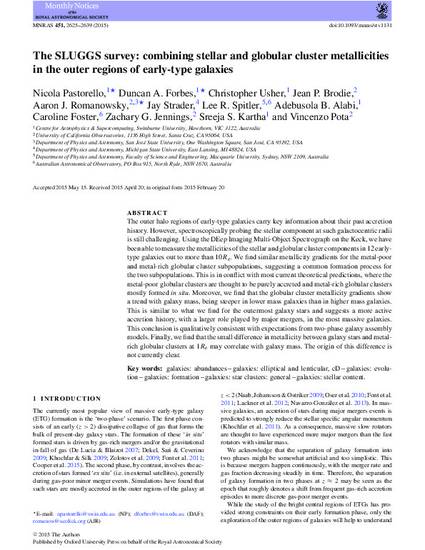
Article
The SLUGGS survey: combining stellar and globular cluster metallicities in the outer regions of early-type galaxies
Monthly Notices of the Royal Astronomical Society
(2015)
Abstract
The outer halo regions of early-type galaxies carry key information about their past accretion history. However, spectroscopically probing the stellar component at such galactocentric radii is still challenging. Using the DEep Imaging Multi-Object Spectrograph on the Keck, we have been able to measure the metallicities of the stellar and globular cluster components in 12 early-type galaxies out to more than 10Re. We find similar metallicity gradients for the metal-poor and metal-rich globular cluster subpopulations, suggesting a common formation process for the two subpopulations. This is in conflict with most current theoretical predictions, where the metal-poor globular clusters are thought to be purely accreted and metal-rich globular clusters mostly formed in situ. Moreover, we find that the globular cluster metallicity gradients show a trend with galaxy mass, being steeper in lower mass galaxies than in higher mass galaxies. This is similar to what we find for the outermost galaxy stars and suggests a more active accretion history, with a larger role played by major mergers, in the most massive galaxies. This conclusion is qualitatively consistent with expectations from two-phase galaxy assembly models. Finally, we find that the small difference in metallicity between galaxy stars and metal-rich globular clusters at 1Re may correlate with galaxy mass. The origin of this difference is not currently clear.
Keywords
- galaxies: abundances,
- galaxies: elliptical and lenticular,
- cD,
- galaxies: evolution,
- galaxies: formation,
- galaxies: star clusters: general,
- galaxies: stellar content
Disciplines
Publication Date
August, 2015
DOI
10.1093/mnras/stv1131
Publisher Statement
This article has been accepted for publication in Monthly Notices of the Royal Astronomical Society ©: 2015 The Authors. Published by Oxford University Press on behalf of the Royal Astronomical Society. All rights reserved.
This article can also be found online at this link: http://dx.doi.org/10.1093/mnras/stv1131
Citation Information
Nicola Pastorello, Duncan A. Forbes, Christopher Usher, Jean P. Brodie, et al.. "The SLUGGS survey: combining stellar and globular cluster metallicities in the outer regions of early-type galaxies" Monthly Notices of the Royal Astronomical Society Vol. 451 Iss. 3 (2015) p. 2625 - 2639 ISSN: 1365-2966 Available at: http://works.bepress.com/aaron_romanowsky/84/
